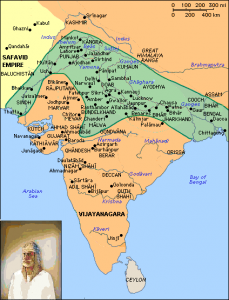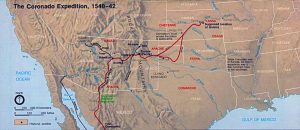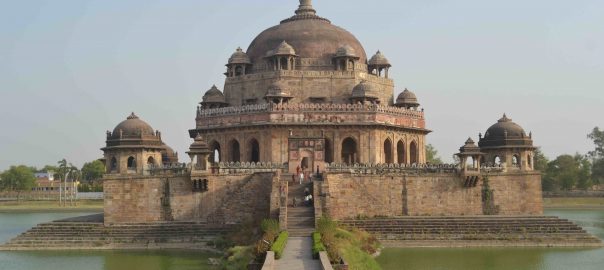Probably the most world-historical development of 1540 CE was something that happened in the north of the Indian subcontinent. But elsewhere, lots of interesting things were happening, too:
-

Maximum extent of Sur Empire (green) In May, an Afghan leader called Sher Shah Suri swept out of the highlands and in a battle at Chausa in Bengal he vanquished the armies of Mughal Emperor Humayun, establishing the Sur Empire in its stead. The Sur Empire lasted only until a Mughal restoration in 1556 (and Sher Shah himself only five years.) English-WP tells us this: “A brilliant strategist, Sher Shah proved himself as a gifted Muslim administrator as well as a capable general. His reorganization of the empire laid the foundations for the later Mughal emperors, notably Akbar, son of Humayun. During his five-year rule from 1540 to 1545, he set up a new economic and military administration, issued the first Rupiya (rupee)… and organized the postal system of the Indian Subcontinent.[10] Some of his strategies and contributions were later idolized by the Mughal emperors, most notably Akbar… He extended the Grand Trunk Road from Chittagong in the frontiers of the province of Bengal in northeast India to Kabul in Afghanistan in the far northwest of the country. The influence of his innovations and reforms extended far beyond his brief reign; his arch foe, Humayun, referred to him as ‘Ustad-I-Badshahan’, teacher of kings. In this seven years of his reign he never lost a battle.” (The tomb of Sher Shah Suri is in the photo above.)
- In the Western Mediterranean, battles continued between the Ottoman and Habsburg (Spanish) forces. In September, Ottoman-backed privateer Ali Hamet took a small naval force to attack the rocky isthmus of Gibraltar, then held by Spain. They took 73 prisoners, plundered 40 vessels in the port, and burnt a galley under construction. That raid turned out to be a big mistake as regional Spanish admiral Bernardino de Mendoza was able to muster and throw into action a force that defeated Ali’s force as it was sailing back to Algiers. That was a fierce battle: “Of the 16 Ottoman ships, ten were captured and one sunk. More than 700 Turks, including all the captains, were killed. In addition, 427 of them were captured and 837 Christian slaves were freed. The Spanish, meanwhile, had 137 dead and about 500 wounded, including Bernardino de Mendoza, who was wounded in the head by a harquebus shot.”
- In Ethiopia, 1540 saw the enthronement of Gelawdewos (Claudius). Like his predecessor, he was getting entangled with the Portuguese…
 In North America, the Spanish conquistador/adventurer Francisco Vázquez de Coronado set out from the north of today’s Mexico to explore lands to the north and northeast in which a small earlier expedition claimed to have found a very rich city called Cibola. (Like Peru! Great plunder for their European finders!) The year before, Vázquez had sent a small scouting mission there which included the well-known Moorish-origin navigator called Estevanico by his Spanish bosses; but Estevanico had been lost, presumed killed by the Indigenes. So in February 1540 Vázquez set out with a group “composed of about 400 European men-at-arms (mostly Spaniards), 1,300 to 2,000 Mexican Indian allies, four Franciscan friars… and several slaves, both natives and Africans.” They wandered up into today’s Arizona, New Mexico, Texas, Oklahoma, and Kansas, but never found Cibola or any of the other fabulously rich cities their smart and wily local Puebloan interlocutors had told them about (“Just go to that next hill!”) His expedition lasted two years before he returned to Nueva Galicia, in the southwest of today’s Mexico, from whence he had started. English-WP tells us: “His expedition had been a failure. Although he remained governor of Nueva Galicia until 1544, the expedition forced him into bankruptcy and resulted in charges of war crimes being brought against him and his field master, Cárdenas. Vázquez de Coronado was cleared by his friends on the Audiencia, but Cárdenas was convicted in Spain of basically the same charges by the Council of the Indies. Vázquez de Coronado remained in Mexico City, where he died of an infectious disease on September 22, 1554… Vázquez de Coronado caused a large loss of life among the Puebloans, both from the battles he fought with them in the Tiguex War and from the demands for food and clothing that he levied on their fragile economies. However, thirty-nine years later when the Spanish again visited the Southwestern United States, they found little evidence that Vázquez de Coronado had any lasting cultural influences on the Indians except for their surprise at seeing several light-skinned and light-haired Puebloans.”
In North America, the Spanish conquistador/adventurer Francisco Vázquez de Coronado set out from the north of today’s Mexico to explore lands to the north and northeast in which a small earlier expedition claimed to have found a very rich city called Cibola. (Like Peru! Great plunder for their European finders!) The year before, Vázquez had sent a small scouting mission there which included the well-known Moorish-origin navigator called Estevanico by his Spanish bosses; but Estevanico had been lost, presumed killed by the Indigenes. So in February 1540 Vázquez set out with a group “composed of about 400 European men-at-arms (mostly Spaniards), 1,300 to 2,000 Mexican Indian allies, four Franciscan friars… and several slaves, both natives and Africans.” They wandered up into today’s Arizona, New Mexico, Texas, Oklahoma, and Kansas, but never found Cibola or any of the other fabulously rich cities their smart and wily local Puebloan interlocutors had told them about (“Just go to that next hill!”) His expedition lasted two years before he returned to Nueva Galicia, in the southwest of today’s Mexico, from whence he had started. English-WP tells us: “His expedition had been a failure. Although he remained governor of Nueva Galicia until 1544, the expedition forced him into bankruptcy and resulted in charges of war crimes being brought against him and his field master, Cárdenas. Vázquez de Coronado was cleared by his friends on the Audiencia, but Cárdenas was convicted in Spain of basically the same charges by the Council of the Indies. Vázquez de Coronado remained in Mexico City, where he died of an infectious disease on September 22, 1554… Vázquez de Coronado caused a large loss of life among the Puebloans, both from the battles he fought with them in the Tiguex War and from the demands for food and clothing that he levied on their fragile economies. However, thirty-nine years later when the Spanish again visited the Southwestern United States, they found little evidence that Vázquez de Coronado had any lasting cultural influences on the Indians except for their surprise at seeing several light-skinned and light-haired Puebloans.”- Of course, Hernando de Soto, whom we first met in 1539, was also throughout 1540 still doing his conquistadoring around the south of the present-day USA.
- Conquistadores still ravaging Peru and elsewhere in the “New World”.
- And over in the Ming Empire, that eccentric guy the Jiajing Emperor announced his intention to seclude himself for several years to pursue immortality; a court official said this was nonsense and got tortured to death. Oops.
